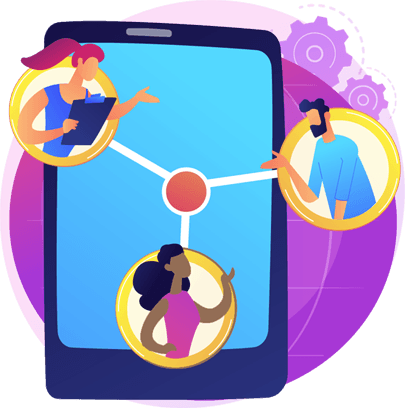
Citizen Developer
It's time to unleash your innovation.
You didn’t take this job for the paperwork. But then there were software migrations and new systems layered on top of old systems. Processes became more complex and swivel-chair operations took over: copy data from this app, turn and paste it into that one.
It may be a cumbersome mess, but you know it better than anyone. Now, your department has been selected to pioneer digital process automation. Armed with firsthand knowledge, a growth mindset, and an eye for efficiency, you can reclaim your humanity and refocus on the parts of the job you love.
You don't need to be a developer!
Nearly 60% of all custom apps are now built outside the IT department. Of those, 30% are built by employees with either limited or no technical development skills.
Initial
Engagement
A member of the C-suite has taken on the role of Executive Sponsor for your company’s automation initiative. They have tasked your department with assembling a process inventory, a set of high-volume, repetitive, rule-based processes ripe for automation. When considering possible candidates, your Team Lead urges you and your coworkers to think about problems that might be solved and opportunities created by automation. She shares the Automation Playbook, a planning document currently under construction. It includes enterprise-wide strategic objectives, metrics, and a rough timeline for the first round of implementations.


At first, you may not be sure what qualifies as an automation-suitable process or how specific you need to get. But Mind Over Machines is your partner in this exploration. You will know exactly what to expect when your team is ready to share its process inventory.
For our process documentation session, you demonstrate the processes you know best. Our analyst will watch closely (and record) as you run 5 records (orders, invoices, claims, whatever they are). Then, you run 5 more, but this time, the analyst asks all kinds of Why? and What if? questions throughout. We will also note the frequency and duration of each proposed process to build the business case for automation.
MINDs consultants take all the data you provide, prepare automation solutions with cost estimates, and plot a roadmap, sequencing your processes into successive implementation waves. Once this Statement of Work receives Executive Sponsor approval, we will be spending a lot of quality time together.
When we blend our technical and business process expertise with your insider knowledge and that wish list of all the ways you know workflows can be improved, we will optimize each process before automating. Look at this as your chance to build your dream job. Delegate the tedious tasks to the bots and keep the interesting, creative, human stuff for yourself.

As soon as we have metrics on time saved and value added, be ready to take the show on the road, evangelizing automation to the rest of the company. You are officially an Automation Ambassador.
Center of Excellence Creation & Evolution:
Your Role
The CoE is both a strategic and tactical body. It champions and implements automations across the enterprise. Over the course of your company’s automation journey, CoE composition will transform from largely Mind Over Machines consultants to in-house, homegrown talent. If you want to grow your citizen developer potential, take advantage of our mentoring program. We’re always here if you need us, but the CoE’s end goal is self-sufficiency.
The CoE has 5 responsibilities:
Click each item to learn more.

Your CoE Responsibilities
You'll find these helpful...
From free webinars to strategic planning exercises, each one has been created or curated to guide you on your automation journey.
Test a Process [Free Calculator]
In just 5–10 minutes, easily identify processes in your organization that can be automated with the Automation Suitability Calculator. You will receive an immediate evaluation of where your process falls on the scale of automation readiness.
The Rise of the Citizen Developer [Webinar]
People know the kinks in their workflows and the inefficiencies in their processes. Employees may not know how to write code, but if you give them intuitive, visual process-driven development tools, they will put them to work. That’s why the low-code/no-code revolution is catching on like wildfire. Watch this webinar to find out more.
The Proof Is in the Metrics [Infographic]
See the impressive real-life results of a human-centric automation engagement with a top healthcare system.
Workforce Ascension(SM)
& Enhancement (WAE) [Framework]
WAE lifts the global workforce to fulfill human potential with a human-centered approach to automation. The WAE Framework includes a proprietary four-phase approach, a set of guiding principles, and a set of specific activities to guide organizations through their journey.
Automation is Efficiency: No Tech Required [Article]
Automation isn’t a project or a technology. Automation is a mindset. It’s approaching work with the goal of reducing human intervention in business processes in order to amplify the value of humans in the business..
Human V. Robot [Infographic]
When it comes to the modern workforce, humans and machines will need to work together to better efficiency, avoid disruption, and increase innovation. This infographic explores which jobs to leave to the bot, to let the humans shine!
How Automation Can Provide Agency To
Today’s Employees [Article]
Traditionally regarded as a job taker, automation can be used to empower employees. As an employee, you can use automation to examine your work and identify what you’re doing and why.
Discover Your Core Competency [Free Download]
What makes your organization (or even you as a person) valuable to others? This free exercise will help you answer that question to start improving business processes and maximize innovation.
What are you thinking now?
Temperature Check! How do you feel about implementing a human first approach to automation?
